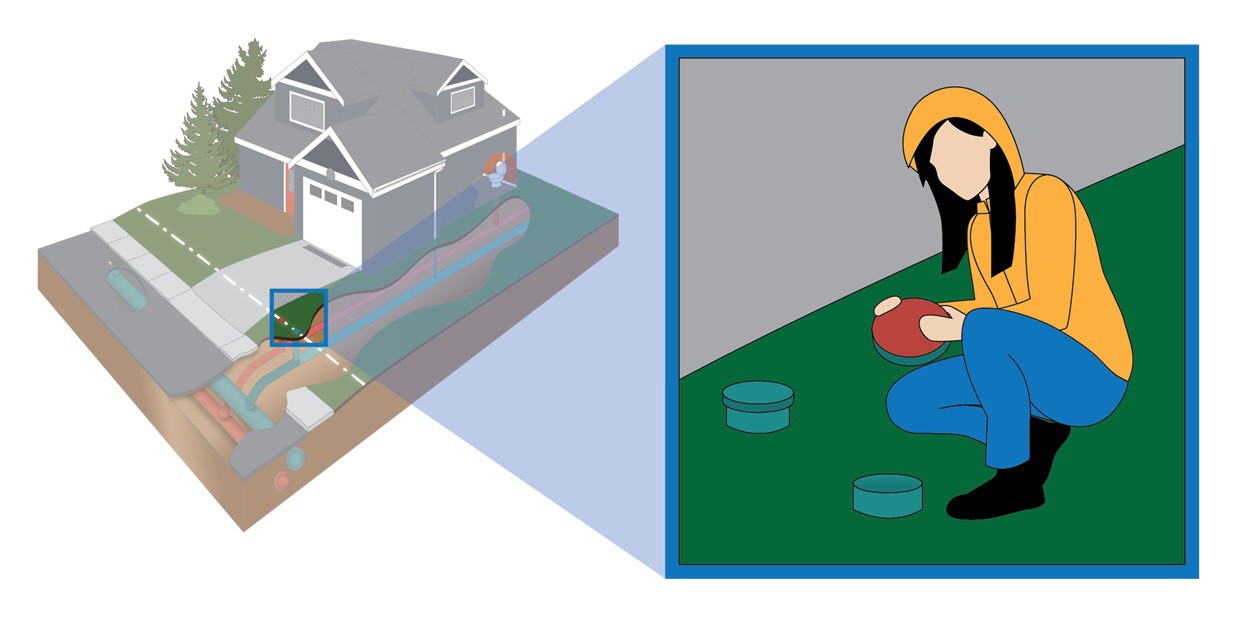Protecting our sanitary sewer system
We are working hard to prevent rainwater from entering our sanitary sewer system, which can lead to health and environmental issues, damage to private residences, and significant additional costs for all of us.
Find out what we're doing to reduce the risk, and learn what role you have to play.
Do you live in the Lynn Valley area? You may qualify for assistance to improve your sanitary or storm sewer. See the last section on this page for details.
But first, learn how the storm and sanitary sewers work
The District has two separated sewer drainage systems: storm and sanitary.
Storm sewer
Rain from your roof, driveway, or patio is directed to your home's storm drainage system.
Your drainage system should connect to our storm sewer system, which runs past your house, and sends the stormwater to local waterways, and eventually, to Burrard Inlet.
This same system — which is built to take the high flows that our west coast weather delivers — also drains roads and parking lots.
Sanitary sewer
Your sinks, toilets, tubs, laundry facilities, and other inside drains are connected to your home's sanitary drainage system.
This system should connect to our sanitary sewer system, which runs past your house, and directs sewage to our local sewage treatment plant for processing.
The sanitary sewer system is built to take all the domestic sewage.
Explore this interactive graphic to understand how the parts of the system work together.
Why rainwater in the sanitary sewer system is a problem
When too much rainwater gets into the sanitary sewer, it can cause a number of problems.
Environmental
Excess rainwater in the sanitary sewer pipes can make them overflow.
As well, if excessive rainwater makes its way to the wastewater treatment plant through sanitary sewer pipes, it could push the treatment plant beyond its capacity, causing excess water to be released.
Public health
Rainwater in the sanitary sewer can cause untreated sewage to back up into your basement, your downstream neighbours' basements, or into the street.
Cost
If excess rainwater caused your sanitary sewer to back up into your basement, the cost of remediation could be significant.
More significant costs come from consistently pushing a wastewater treatment plant beyond its capacity, which directly impacts your utility rate.
How does rainwater get into the sanitary sewer system?
Rainwater gets into the sanitary sewer system through what's called 'inflow and infiltration.'
Rainwater can flow into the sanitary sewer system when your home's storm drainage system is incorrectly connected to the District sanitary sewer system. It can also come in through holes in manhole covers, and uncapped inspection chambers. This is inflow.
Groundwater can seep into the sanitary sewer system through broken pipes, cracks, or bad joints in your home's sanitary drainage system. This is infiltration.
Your role in protecting our system
A lot of the rainwater that makes its way into our sanitary sewer comes from private property. As a homeowner, there are several things you can do to help prevent it:
- Avoid planting any trees or shrubs over your sanitary or drainage systems
- Replace or repair any cracks or broken connections in your pipes
- Check to make sure your gutters and downspouts are connected to your storm drainage system, not your sanitary drainage system
- Keep your sanitary and storm drainage systems in good repair
How to check your connections for inflow or infiltration
It's easy to find out if rainwater is making its way into your sanitary sewer line. Here's what to do:
- On a rainy day, pick a time when you are not using any water in your house
- Go outside to the inspection chamber for your sewer line (see diagram, above, for help)
- Remove the lid from the inspection chamber and look inside (don't forget to secure the lid when you're done)
- If there is water flowing through the pipe, you have rainwater inflow or infiltration

If you suspect you have a problem with inflow or infiltration, please complete the form at the bottom of this page, and our Inflow and Infiltration Specialist will contact you with advice and help.
Our role in protecting our system
We are always watching our sanitary sewer system for signs of inflow or infiltration. We do this through flow monitoring, and through field inspections in problem areas.
We also repair problems as we find them, which can include repairing joints, replacing pipes, sealing leaks, or repairing cracked pipes.
Special project in the Lynn Valley sewershed
We undertake larger projects to update the sanitary and storm sewer systems, such as the project currently underway in the Lynn Valley sewershed.
While inflow and infiltration is a problem District-wide, the Lynn Valley sewershed is our highest priority (that's the area shown on this map). If you live in the Lynn Valley sewershed and are interested in this program, please complete the form on this page, and our Inflow and Infiltration Specialist will be in touch with more details.
Use this form to request advice or help
If you suspect you have rainwater entering the sanitary sewer system at your property — or you would like to learn more about our inflow and infiltration program in the Lynn Valley sewershed — please complete this form, and we will be in touch.